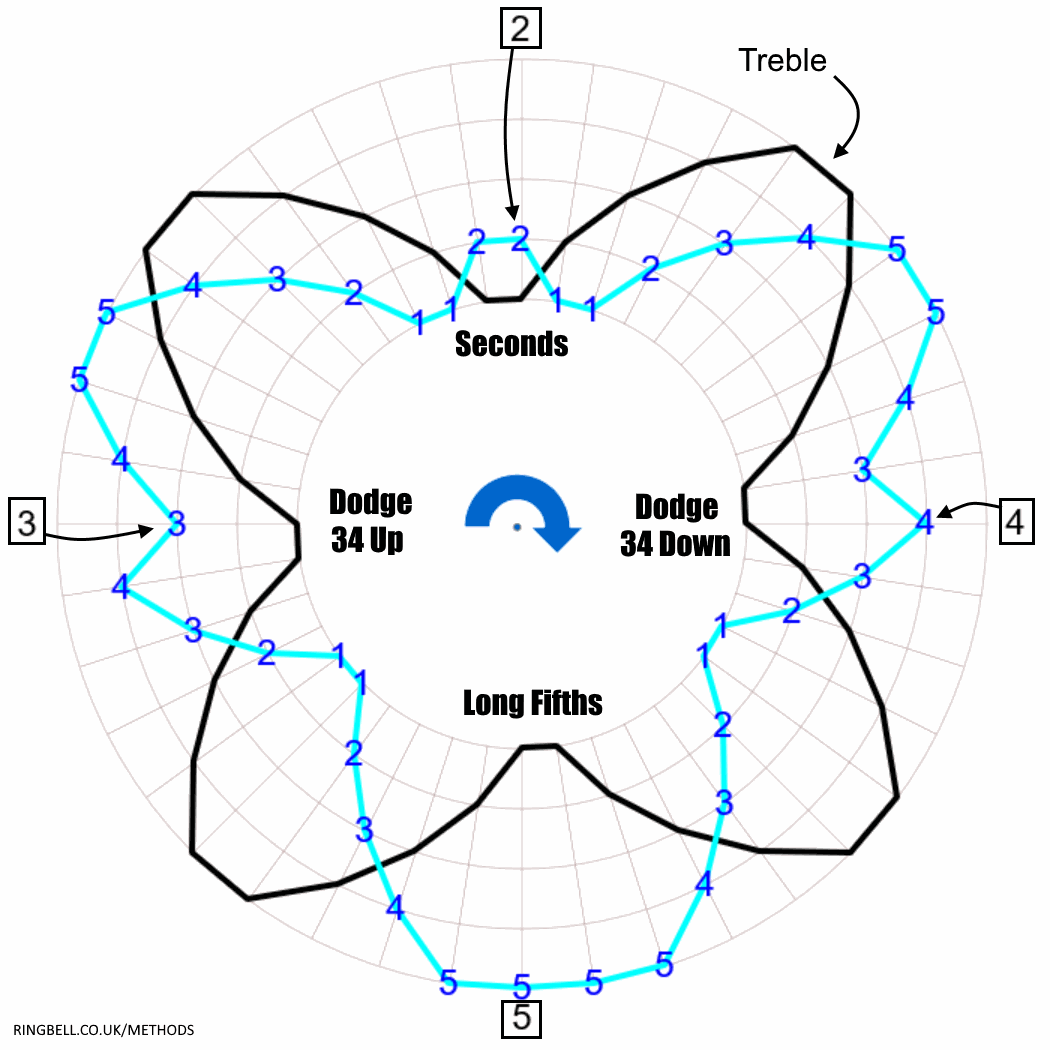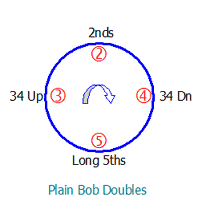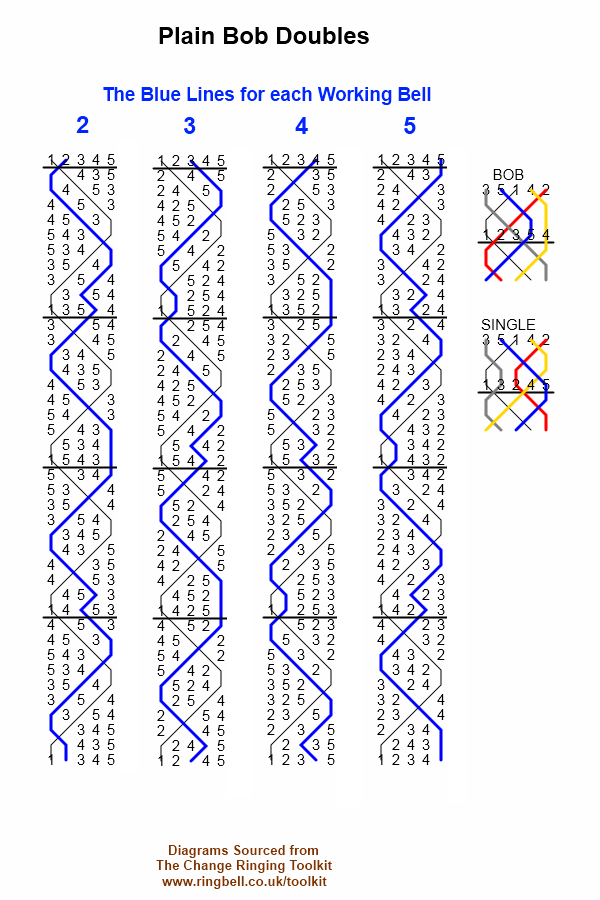The Approach
Before moving on to ring Plain Bob Doubles, you should be pretty competent in ringing Plain Hunt on five bells with the tenor covering. When learning Plain Hunt you can get away with learning which bell to follow in sequence. A plain course of Plain Bob Doubles lasts for 40 changes which is too long for most people to recall from memory accurately. Should you want to ring any of the four working bells, you would have to remember 4 times 40, that is 160 bells to follow. So we must take a different approach and learn to ring it by places and the pattern of the Blue Line.
For your own sanity it is best to refer to bells as Treble, Two, Three, Four, Five and Tenor (Six) and count your places as Seconds, Thirds, Fourths, Fifths and Leading. This scheme is adopted here.
Plain Bob Doubles Places in a Circle of Work

The diagram shows the Blue Line Circle for Plain Bob Doubles, the blue numbers on the line are the places. Each bell starts from the position marked by the number in the square box, 2 at the top, 4 to the right, 5 on the bottom and 3 on the left, and ends there too. During the method all the four working bells (2,3,4 and 5) complete one pass around the circle in a clockwise direction indicated by the arrow in the centre.
By learning the 40 places around the circle it makes our life a little easier as all four working bells pass along that same line but start from different points, rather than learning 160 bells to follow.
But it is not as difficult as it might seem. Once we can ring Plain Hunt, we can apply that to solving the problem.
Comparing Plain Bob with Plain Hunt, using the number 2 bell as an example, the section of plain hunt marked by the red arrow, from the starting point to the dotted red line, is exactly the same in Plain Hunt as Plain Bob. At the red dotted line the treble leads and the two is in 3rd place, this is the same for both methods. It is the next change where the pattern alters. Instead of returning to 2nd place where is started in Plain Hunt, it jumps back to 4th place in Plain Bob.

We can think of Plain Bob as just Plain Hunt with four different pieces of work that occur when the treble leads. Therefore we just need to learn those pieces of work.
Before looking at the four pieces of work in detail, we need to remember the order in which they happen. Each bell has a different perspective because it starts at a different point in the 'Circle of Work' but the order always remains the same.
Dodging - A new concept
Moving from Plain Hunt to Plain Bob involves a new piece of work, the dodge. You should be familiar with ringing slightly slower than rounds when going up the places and slightly quicker coming down the places. Dodging requires a change of speed twice in quick succession.
To dodge 34 down, at the handstroke at 3rd place pull the sally a little harder and allow the backstroke to rise into 4th place over the bell you are dodging with. Don't pull that backstroke hard and check the sally into 3rd place. Dodging 34 Up is the reverse, don't pull the sally so hard at handstroke in 4th place, check the backstroke into 3rd place and pull it a little harder to allow the sally to rise into 4th place over the bell you are dodging with.
Getting Down to Learning
Ringers don't usually use the circle of work to learn a method, but instead use method diagrams with their bell highlighted in blue (The Blue Line). By convention these diagrams are printed in columns, however some ringers find it easier to rotate the chart by 90 degrees anticlockwise and see the blue line as going up and down rather than left and right. Do it the way that suits you.
It is helpful to know how your bell starts the method and what the first work after you have plain hunted.
Starting Positions in Plain Bob Doubles
 |
Bell
No |
Starts
With |
Starting
Places |
First
Work |
| 2 |
In to Lead |
(2)LL23455.. |
Dodge 3/4 Down |
| 4 |
Hunt In |
(4)32LL234.. |
Long Fifths
(4 Blows in fifths) |
| 5 |
One blow in fifths, then hunt in |
(5)5432LL2.. |
Dodge 3/4 Up |
| 3 |
Hunt out to the back |
(3)455432L.. |
2nds |
Look out for signposts along the way, these are usually in the form of the bell you follow (ring over) at various stages, often the Treble bell. Other signposts are mentioned here, but be very careful not to over complicate things by looking for too many of them. Look at the chart below for your bell to see if you can see the signpost. Certain signposts involve two bells they are shown here as letters because they depend on the bell you are ringing
- When making seconds, you always do this over the Treble bell.
- When making long 5ths, you ring four blows over bells A, B, A, B. You follow the Treble when you are in 4th place when going into and leaving long 5ths.
- Is it 34 Up or 34 Down? Think of the circle as a clock, you are the hand, so make 34 down when the hand is going in a downward direction and 34 Up when going upwards.
- At 34 Down, you follow bells J, K, J, Treble, K in places 4th, 3rd, 4th, 3rd, 2nd.
- 34 Up is a mirror image. you follow bells P, Treble, Q, P, Q in places 2nd, 3rd, 4th, 3rd, 4th.
Here are four charts, one for each working bell. The changes in each column are the same but the Blue line is tailored for that bell. Treble ringers can use any column. The Tenor is not shown on method diagrams, but they cover, following whatever bell is in the 5th place column. This normally means they ring backstroke and handstroke over each bell except at the end of the lead when a bell makes long 5ths, so its 4 blows over that bell.
The horizontal stave lines break the method up into four sections (called leads) the row of bells above the stave is the 'lead head' also known as the 'Lead End' by some ringers.



 2nds
2nds 3/4 Down
3/4 Down Long 5ths
Long 5ths 3/4 Up
3/4 Up
